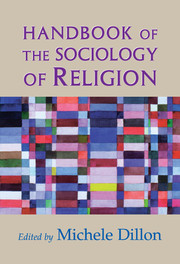Book contents
- Frontmatter
- Contents
- List of Contributors
- Acknowledgment
- Part One Religion as a Field of Sociological Knowledge
- 1 The Sociology of Religion in Late Modernity
- 2 Studying Religion, Making it Sociological
- 3 The Ritual Roots of Society and Culture
- 4 Social Forms of Religion and Religions in Contemporary Global Society
- 5 The Evolution of the Sociology of Religion
- Part Two Religion and Social Change
- Part Three Religion and the Life Course
- Part Four Religion and Social Identity
- Part Five Religion, Political Behavior, and Public Culture
- Part Six Religion and Socioeconomic Inequality
- References
- Index
4 - Social Forms of Religion and Religions in Contemporary Global Society
Published online by Cambridge University Press: 05 June 2012
- Frontmatter
- Contents
- List of Contributors
- Acknowledgment
- Part One Religion as a Field of Sociological Knowledge
- 1 The Sociology of Religion in Late Modernity
- 2 Studying Religion, Making it Sociological
- 3 The Ritual Roots of Society and Culture
- 4 Social Forms of Religion and Religions in Contemporary Global Society
- 5 The Evolution of the Sociology of Religion
- Part Two Religion and Social Change
- Part Three Religion and the Life Course
- Part Four Religion and Social Identity
- Part Five Religion, Political Behavior, and Public Culture
- Part Six Religion and Socioeconomic Inequality
- References
- Index
Summary
CONCEIVING AND DEFINING RELIGION AND RELIGIONS
It may seem to many readers that religion is a fairly straightforward notion, easily bringing to mind clear and concrete pictures: A group of Muslims at daily prayer, a Christian priest saying mass, a Buddhist monk or nun meditating, a person lighting a votive or holiday candle, and myriad other possibilities. Yet, as in several other domains of social life, such as art, sport, and that ever elusive term, culture, what seems clear at a quick and first glance is anything but upon further reflection. If a Shakespearean play and neolithic cave paintings count as art, what about the arrangement of flowers on the dining room table, a television advertisement, or the rousing performance of a popular politician on the hustings? If ice dancing is an Olympic sport, why isn't ballroom dancing even a sport? If dim-sum is part of Chinese culture, how many kung-fu centers do there have to be in Houston or San Francisco before they become an expression of American culture? Similarly, while most readers may agree that what happens in a Jewish synagogue or at a Shinto shrine qualifies as religion, many people in Western countries have just as serious doubts about what happens at a Scientology course as government officials in China have about Falun Gong. The Church of Jesus Christ of Latter-Day Saints and the Brahma Kumaris are clearly religious groups; are they also Christian and Hindu, respectively?
- Type
- Chapter
- Information
- Handbook of the Sociology of Religion , pp. 45 - 60Publisher: Cambridge University PressPrint publication year: 2003
- 13
- Cited by



